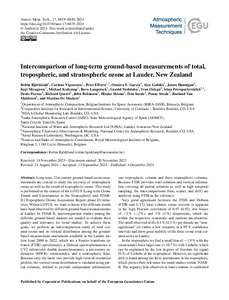Por favor, use este identificador para citar o enlazar este ítem:
http://hdl.handle.net/20.500.11765/16375
Intercomparison of long-term ground-based measurements of total, tropospheric, and stratospheric ozone at Lauder, New Zealand
| Título : | Intercomparison of long-term ground-based measurements of total, tropospheric, and stratospheric ozone at Lauder, New Zealand |
| Autor : | Björklund, Robin; Vigouroux, Corinne; Effertz, Peter; García Rodríguez, Omaira Elena



|
| Palabras clave : | Ozone; Intercomparison; Troposphere; Measurements; Stratosphere |
| Fecha de publicación : | 2024 |
| Editor: | European Geosciences Union; Copernicus Publications |
| Citación : | Atmospheric Measurement Techniques. 2024, 17(23), p. 6819–6849 |
| Versión del editor: | https://doi.org/10.5194/amt-17-6819-2024 |
| Resumen : | Long-term, 21st century ground-based ozone measurements are crucial to study the recovery of stratospheric ozone as well as the trends of tropospheric ozone. This study is performed in the context of the LOTUS (Long-term Ozone Trends and Uncertainties in the Stratosphere) and TOAR-II (Tropospheric Ozone Assessment Report, phase II) initiatives. Within LOTUS, we want to know why different trends have been observed by different ground-based measurements at Lauder. In TOAR-II, intercomparison studies among the different ground-based datasets are needed to evaluate their quality and relevance for trend studies. To achieve these goals, we perform an intercomparison study of total column ozone and its vertical distribution among the ground-based measurement instruments available at the Lauder station from 2000 to 2022, which are a Fourier transform infrared (FTIR) spectrometer, a Dobson spectrophotometer, a UV2 (ultraviolet double monochromator), a microwave radiometer (MWR), ozonesondes, and a stratospheric lidar. Because only the latter two provide high-vertical-resolution profiles, the vertical ozone distribution is validated using partial columns, defined to provide independent information: one tropospheric column and three stratospheric columns. Because FTIR provides total columns and vertical information covering all partial columns as well as high temporal sampling, the intercomparisons (bias, scatter, and drift) are analyzed using FTIR as the reference. |
| URI : | http://hdl.handle.net/20.500.11765/16375 |
| ISSN : | 1867-1381 1867-8548 |
| Colecciones: | Artículos científicos 2023-2026 |
Ficheros en este ítem:
| Fichero | Descripción | Tamaño | Formato | ||
|---|---|---|---|---|---|
| AMT_Robin_2024.pdf | 3,89 MB | Adobe PDF |  Visualizar/Abrir |
Los ítems de Arcimis están protegidos por una Licencia Creative Commons, salvo que se indique lo contrario.





